4. My First Project: Draw a Rug
If I remember correctly, the first animation Kotabe-san drew for us was of Luigi spinning around in circles. But we couldn't use that many frames, so we couldn't use it in a game.
Yeah. At that time I was drawing a lot of stuff that no one could use.
But then an opportunity arose for something I thought we should definitely ask Kotabe-san to work on. We did it together with Fuji Television.
Yume Kojo: Doki Doki Panic13.
13 Yume Kojo: Doki Doki Panic was a game developed for the Family Computer Disk System in cooperation between Nintendo and Fuji Television and released in 1987. It later became the basis for Super Mario Bros. 2, originally released in 1992.
Ah, I remember it.
I wanted the rug movement to be smooth.
Oh, that. (laughs)
I wanted it to move like a real rug, and I thought I'd ask Kotabe-san. To Kotabe-san, the great illustrator, I said, “Please, draw me a rug!”
How awful. (laughs)
(laughs)
So I drew him a rug that moved smoothly, and he told me it had too many frames!
The original animation had over ten frames, but we needed to cut some out and repeat the same ones over and over so the frame count would be low but the rug's movement would be smooth.
I think it was three. And we used them in reverse, too.
That was the first video game work I ever requested from Kotabe-san.
You also asked him to do a lot of illustrations for Mario.
Mario was pixel art, so the only reference was the package illustration for Super Mario Bros.
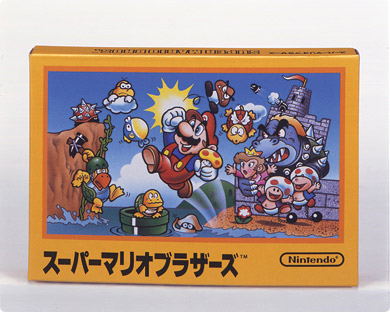
That's right. Kotabe-san turned that into the Mario we see today.
Ever since we made Donkey Kong14, I had made many rough sketches of Mario in pencil and then given them to an external illustrator to polish up. When we came out with Super Mario Bros., I was thinking about asking a professional manga artist or a well-known illustrator to do the art, but time was running out, so I drew the original art for the package myself.
14 Donkey Kong was a Nintendo arcade game that appeared in 1981. It was released for the NES in 1983.
So when I went to draw Mario, that one package illustration was all I had to go by. Then I heard Miyamoto-san was the artist, so I asked him all sorts of questions. Is this face ok? Is he like this?
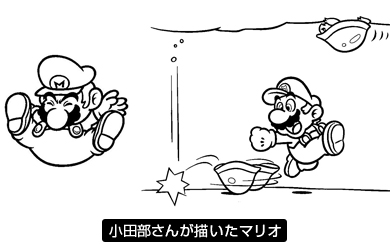
That's right. He asked me a lot of questions. What's incredible is that both Kozai-san and Kotabe-san are so amazingly talented.
Someone who was far better at drawing was asking you how to draw something. You must have really liked that. (laughs)
(laughs)
Peach completely changed. I told him everything I wanted, like how I wanted the eyes to be a little cat-like.
And how she should look stubborn.
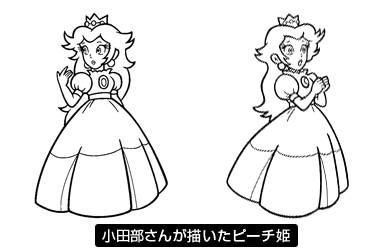
Stubborn, but a little cute. (laughs) Bowser changed a lot, too. I'd been drawing Mario for quite a while, so I knew what I wanted him to look like, but I hadn't drawn Bowser that much, so I couldn't get the lines to come together right. I like Toei Animation's work from around the time of Alakazam the Great15, and the ox that appears in that...
15 Alakazam the Great was an animated film released in 1960 and was produced by Toei Animation.
Oh, I remember you talking about that.
I told him how I liked that ox.
The ox king. Miyamoto-san liked that ox, and that was how he imagined Bowser. When you see the package art he drew, Bowser does look a bit like an ox. But after that, Takashi Tezuka said...
He said it was a turtle.
I thought, “Oh, it's a turtle?”
(laughs)
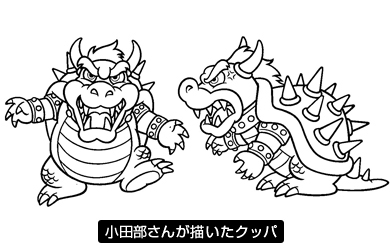
I'd been drawing something completely incomprehensible—a turtle's body with an ox's head! (laughs) Through our discussions, his appearance eventually came together, though. Since Bowser was in the turtle family together with the Koopa Troopas, we began to see similar lines between the two, so we copied those as faithfully as possible and moved onto the next illustration. I started congratulating myself, saying, “Wow, I can really make Bowser look cool now!”
You learned from Kotabe-san's drawings, introduced them into the game, and it would suddenly look a lot better. Later on, games started becoming 3-D, and Kotabe-san's skills became even more important for us.
When we were making Super Mario 6416, the development staff was always holding meetings.
16 Super Mario 64 is a 3-D platform game released for the Nintendo 64 in 1996.
Since we're talking about Mario 64, let's have Koizumi-san join the conversation. I had intended to have him join in when we got to Flipnote Studio, though.
No problem.
Koizumi-san, how did you first meet Kotabe-san?
The first person I worked with after entering the company was Kotabe-san.
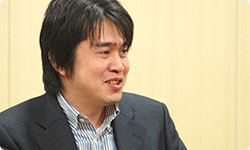
To tell the truth, I consulted Kotabe-san about hiring you. (laughs)
Really?! (laughs)
The two of them conducted my interview.
Koizumi-san brought some animation he had created as his graduation project, and I watched it. He actually had experience making animation. Anyway, for some reason I was one of the interviewers. I badgered him with a bunch of nasty questions, like, “If you're so good at animation, why do you want to join the video game industry?”
So I started expounding animation theory and even video game theory.
It's quite a student who would dare to explicate animation theory in front of Kotabe-san and video game theory in front of Miyamoto-san!
(laughs)
I had no idea that the two people in front of me were Kotabe-san and Miyamoto-san! Even if I knew their names, I didn't know what they looked like. Besides, I was just a student and really nervous. I thought there was nothing to do but go for it, so I started rattling on about my pet theories. I shudder to think about it now. (laughs)
Miyamoto-san told me you were supposed to keep working as a character illustrator for a while.
I told him to develop Koizumi-san's skills.
Really? I didn't know that.
What I remember well from that time is Mario Kart17. At Toei Animation, they always said, “Look at the real thing,” so I forced through a budget to do just that.
17 Super Mario Kart was originally released in 1992 for the Super NES.
We set out for some field research. I drove a go-kart for the first time and closely observed their structure.
Looking at photos or searching for material on the Internet isn't enough. You've got to see the real thing and take it all inside yourself. That field trip really paid off when we made Mario Kart.
Yes. Thanks to you.
But then the game development became short-staffed, and Koizumi-san got taken away from me.
Miyamoto-san asked you to develop his skills, then snatched him away. (laughs)
That's why I've been trapped at Nintendo for 21 years!
(laughs)